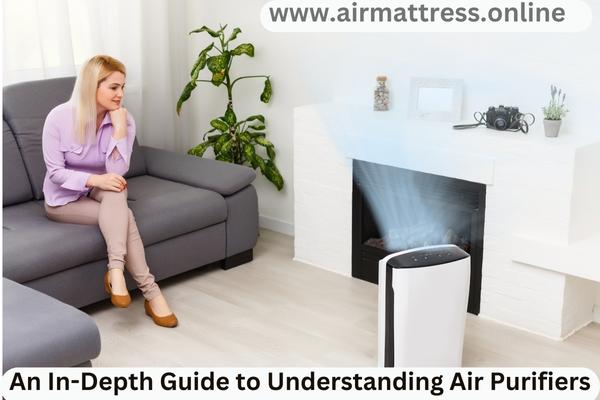Introduction:
Indoor air quality is a vital aspect of maintaining a healthy living environment. As awareness of the importance of clean air grows, so does the popularity of air purifiers. These devices offer a way to filter and purify our air, reducing pollutants and allergens.
In this SEO-optimized article, we will explore the concept of air purifiers, their benefits, how they work, and factors to consider when selecting the right one for your needs.
- Defining an Air Purifier:
An air purifier is a device designed to improve indoor air quality by removing various airborne contaminants. It utilizes a combination of filters, technologies, and mechanisms to capture and eliminate particles, such as dust, pollen, pet dander, mold spores, and even volatile organic compounds (VOCs) and odors.
- Benefits of Using an Air Purifier:
a. Improved Indoor Air Quality:
The primary benefit of an air purifier is the significant improvement in indoor air quality. Removing pollutants, allergens, and irritants from the air helps create a cleaner and healthier living environment.
b. Allergy and Asthma Relief:
Air purifiers can particularly benefit individuals with allergies or asthma. They can alleviate symptoms and create a more comfortable space by capturing and eliminating common triggers like pollen, dust mites, and pet dander.
c. Odor and VOC Reduction:
Air purifiers incorporate technologies to address unpleasant odors and reduce volatile organic compounds (VOCs) emitted from household products, paints, and cleaning chemicals. This can contribute to a fresher and more pleasant indoor environment.
d. Respiratory Health Support:
Cleaner air free from airborne pollutants can help support respiratory health, reduce the risk of respiratory infections, and provide relief for individuals with respiratory conditions.
e. Improved Sleep:
By removing airborne particles that may disrupt sleep, such as dust and allergens, air purifiers can provide a more restful and rejuvenating sleep experience.
- How Do Air Purifiers Work?
Air purifiers employ various techniques and technologies to purify the air. The most common methods include:
a. Filtration:
Many air purifiers use filters, such as HEPA (High-Efficiency Particulate Air) filters, to physically capture and trap airborne particles as air passes through them. HEPA filters can remove particles as small as 0.3 microns with high efficiency.
b. Activated Carbon Filters:
These filters effectively capture and neutralize odors, smoke, and VOCs. The activated carbon material absorbs and traps the odorous or gaseous molecules, improving air quality and reducing unpleasant smells.
c. UV-C Sterilization:
Air purifiers use ultraviolet (UV) light technology to kill bacteria, viruses, and mold spores by damaging their DNA. This method can help prevent the spread of airborne pathogens.
d. Ionization:
Ionizers release negative ions into the air, which attach to airborne particles, causing them to become heavier and settle on surfaces. This process helps remove particles from the air, but it’s important to note that some ionizers may produce trace amounts of ozone.
- Considerations When Choosing an Air Purifier:
a. Room Size and Coverage:
Determine the room size or area where the air purifier will be used. Choose a model with an appropriate coverage area to ensure efficient purification.
b. CADR (Clean Air Delivery Rate):
Look for air purifiers with a high CADR rating, indicating the device’s ability to remove pollutants from the air. Higher CADR ratings are more effective in larger rooms.
c. Noise Level:
Consider the noise level generated by the air purifier, especially if it will be used in bedrooms or other quiet areas. Look for models with adjustable fan speeds or a “quiet” or “sleep” mode.
d. Filter Replacement and Maintenance:
Check the ease of filter replacement and the cost of replacement filters. Regular maintenance is crucial for optimal performance, so consider the filter lifespan and the manufacturer’s recommendations.
e. Energy Efficiency:
Look for air purifiers with an ENERGY STAR certification, designed to be energy-efficient and minimize operating costs.
- Additional Features:
Different air purifiers may offer additional features to enhance convenience and usability. These may include programmable timers, air quality sensors, digital displays, remote controls, and multiple fan speeds. Consider these features based on your preferences and specific needs.
Conclusion:
Air purifiers play a vital role in creating a cleaner and healthier indoor environment by removing airborne pollutants, allergens, and odors. Understanding the benefits, functionality, and considerations of selecting an air purifier is essential to make an informed decision.
By prioritizing factors such as room size, filtration methods, noise level, maintenance requirements, and additional features, you can choose an air purifier that meets your needs and contributes to improved indoor air quality for you and your loved ones.
With the right air purifier, you can breathe easier, sleep better, and enjoy the benefits of cleaner air in your home or office space.
Prioritize your health and well-being by investing in an air purifier that suits your requirements, and experience the transformative effects of fresh, purified air in your daily life.

